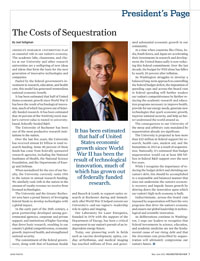President’s Page
America’s research universities play an essential role in our nation’s economy. The academic labs, classrooms, and clinics at our University and other research universities are a wellspring of new ideas and talent that form the basis for the next generation of innovative technologies and companies.
Fueled by the federal government’s investment in research, education, and health care, this model has generated tremendous national economic benefit. It has been estimated that half of United States economic growth since World War II has been the result of technological innovation, much of which has grown out of federally funded research. It has been estimated that 30 percent of the NASDAQ stock market’s current value is rooted in university-based, federally funded R&D.
The University of Rochester has been one of the most productive research institutions in the nation. Over the last five years, the University has received almost $2 billion in total research funding. Some 80 percent of these funds has come from federally sponsored research agencies, including the National Institutes of Health, the National Science Foundation, and the Departments of Energy and Defense. When normalized for the size of our faculty, the University currently ranks 15th in the nation in annual research funding. We similarly rank 13th in the nation in the amount of royalty revenue we receive from licensed technologies.
The University and the Greater Rochester area have a proud history of leveraging federal funds to develop technologies with a global impact. In the early part of the 20th century, a great partnership developed among governmental agencies, corporate and private support, and institutions of higher learning that drove basic research, resulting in our country’s global competitiveness, economic growth, improved health, and strengthened national security. The commitment of the federal government, along with that of Eastman Kodak and Bausch & Lomb, to support optics research at Rochester during and immediately after World War II helped cement our University’s—and our region’s—leadership role in optics and imaging. Our Laboratory for Laser Energetics, founded in 1970 with the support of the Department of Energy, has been a critical component in our nation’s pursuit of an independent energy future. Today, our pioneering work in fields such as vaccine development, optics, cardiac arrhythmias, and medical imaging has touched millions of lives and generated substantial economic growth in our community.
At a time when countries like China, India, South Korea, and Japan are accelerating their investments in research and development, the United States sadly is now reducing this federal commitment. Over the last decade, the budget for NIH alone has fallen by nearly 20 percent after inflation.
As Washington struggles to develop a balanced long-term approach to controlling the federal budget deficit, the imposition of spending caps and across-the-board cuts in federal spending will further weaken our nation’s competitiveness by further reducing the academic research and education programs necessary to improve health, provide for our energy needs, generate new technologies that spark economic growth, improve national security, and help us better understand the world around us.
The consequences to our University of the steep and arbitrary cuts mandated by sequestration already are significant. The University is projected to lose more than $23 million in federal support for research, health care, student aid, and the humanities in 2013 as a result of sequestration. Nationally, it’s estimated that budget sequestration would cut at least $50 billion in federal R&D support over the next five years.
While I recognize the importance of reducing the budget deficit and shrinking our nation’s debt, this should be accomplished in a responsible and balanced manner that does not undermine the nation’s economic recovery and impede future growth by slowing down the innovation upon which our nation’s high-tech economy is built. Indiscriminate, across-the-board cuts imposed by sequestration will hurt the very programs that drive the nation’s economy and ensure our global leadership in technological and scientific innovation.
As deliberations continue in Washington, I urge our leaders to recognize that federal investments in science, education, and academic medicine are not the fundamental cause of our rising debt and that the draconian cuts prescribed by sequestration will ultimately compromise our nation’s future.

